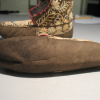moccasins
moccasins
moccasins











A pair of black dyed hide moose hair embroidered moccasins, probably Huron-Wendat, made between 1810 and 1830. They are distinctive in their construction, with puckered toe vamps and stand up cuffs that are made from separate pieces. They were transferred to the Pitt Rivers Museum from the South Kensington Museum in 1884.
In this period, Wendat women were doing this kind of embroidery. The quality of the moccasin construction also suggests that this was done by the Wendat as opposed to French convent work. Ruth Phillips adds that the nuns did not know how to make moccasins.
Pitt Rivers Object catalogue and observations made by the GRASAC research team.
Read More About This Relative
hand-tanned blackened hide; moose hair, white, blue, original deep/bright orange (now faded to light orange); silk ribbon, red; thread, commercial cotton/linen
The moccasin is tightly puckered around the toe vamp, with separate cuffs in a stand up cuff design. This design of cuff usually laced across the front of the ankles, but on this pair there are no holes, indicating that this pair was never worn. The moccasins are constructed with a Y-shaped heel seam. The foot is turned up and gathered to the vamp with ca. 58 puckers. CW and LP note that the puckering comes up unusually high on the vamps. The vamp is long and narrow, extending to form the tongue. The ankle flaps are made in two parts, joined at the back by the continuation of the heel seams. They are shaped to meet edge to edge over the instep as in a European boot.
There is extensive embroidery on the vamp, on the outside of ankle flaps and on the foot piece around the ankle. CW and RP suggest that the scalloped line that runs around the outside border of the vamp possibly resembles the sky dome motif. On the cuff are double curves, parallelograms, and floral designs with curvilinear lines between the flowers. Rectangular embroidered panels along the upper edge of the body of the moccasin could stylistically represent a flap.
RP suggests a link with Dorothy Burnham's book about painted hide coats, including triangles which implied the mountains where the Lord of the Caribou dwelt. Possibly the triangles on this pair refer to mountains. A four dimension motif is also possible. SL suggests a play of symmetry and balance across the design, grouping some items. Interlocking colour balances the arrangement of elements. See Cory's thesis, chapter on "Clothing of a New Kind".
RP notes that this pair of moccasins is an example of the kinds of items made in the eighteenth century by Aboriginal women in convents, to be either sent to patrons in France who were collectors of curiosities or sold to tourists.
The seam at the back of the cuff is very peculiar (CW) and the stand-up cuff with no holes for lacing were also unusual. AD asked if there a is a relation between fineness of stitching and exchange context. CW suggests that these made for the European, commercial market, which in this period sought fineness of women's handiwork. This example of fine needlework relates to English embroidery of the same period. RP notes that the sort of puckering found around the vamps is characteristic of eastern Cree and eastern Algonkian moccasins.
1815-1835-- this estimate by Ruth Phillips is based on similarity to a documented collection in Bern, Switzerland: similar moccasins held at the Berne Historical Museum, in the von Pourtalés collection, have a date of manufacture of 1832.
By this period, Wendat women were making moose-hair embroidered moccasins.
Ruth Phillips also notes that a taste for black smoked hides was most common in the late eighteenth century.
Provenance
This object was listed in the Delivery Catalogue as having been transferred from South Kensington Museum in 1884. It was delivered to South Kensington Museum in February 1880.
It was probably displayed at South Kensington Museum (V&--A) between 1880 and 1884.
Similar moccasins are found in the von Pourtalés collection, held at the Berne Historical Museum. See Thompson, Judy, The North American Indian Collection: A Catalogue, Bern, 1977.
For a discussion on color symbolism, see Willmott, Cory. “Clothed Encounters: The Power of Dress in Relations between Anishnaabe and British Peoples in the Great Lakes Region, 1760-2000” [PhD Dissertation] McMaster University, 2001.
About This GRASAC Record
This record was created as part of a Great Lakes Research Alliance for the Study of Aboriginal Arts and Cultures (GRASAC) research trip to the Pitt Rivers Museum and British Museum, December 8-22 2007, funded by a grant from the International Opportunities fund of the Social Sciences and Humanities Research Council (SSHRC).
researchers present: Heidi Bohaker (HB), Stacey Loyer (SL), Janis Monture (JM), Laura Peers (LP), Ruth Phillips (RP), Anne De Stecher (AS), Cory Willmott (CW).













Stylistic characteristics
 Knowledge Sharing Platform
Knowledge Sharing Platform










